Avenue Road
Avenue Road is a major north-south street in Toronto, Ontario. The road is a continuation of University Avenue, linked to it via Queen's Park and Queen's Park Crescent East and West to form a single through route.[2] Until January 1, 1998, these roads were designated Highway 11A.
| Avenue Road | |||||||
|---|---|---|---|---|---|---|---|
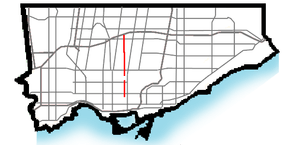 | |||||||
| Route information | |||||||
| Maintained by City of Toronto government | |||||||
| Length | 9.0 km[1] (5.6 mi) | ||||||
| Major junctions | |||||||
| South end | Bloor Street (continues as University Avenue) | ||||||
| St. Clair Avenue Eglinton Avenue Lawrence Avenue Wilson Avenue | |||||||
| North end | Bombay Avenue | ||||||
| Location | |||||||
| Major cities | Toronto | ||||||
| Highway system | |||||||
Roads in Toronto
| |||||||
Route
Avenue Road is the western limit of the former town of Yorkville, officially beginning at Bloor Street and ending just north of Highway 401. At its southern terminus, it runs between two of Toronto's major hotels, the Park Hyatt (on the northwest corner of Bloor and Avenue Road) and the Four Seasons Hotel. On the northeast corner of the intersection with Bloor is the Church of the Redeemer. For much of its length the road is fairly residential, with a mix of small businesses, as well as a few large schools and churches. A notable site along this "lower section" is the Hare Krishna Temple, formerly the Avenue Road Church, opposite Dupont Street and across the street from the Anglican Church of The Messiah. Just north of St. Clair Avenue, Avenue Road is interrupted by Upper Canada College, ending at Lonsdale Road and resuming again at Kilbarry Road. The primary traffic route runs east of the school, following widened sections of Lonsdale Road and Oriole Parkway and returning to Avenue Road via Oxton Avenue. (The short section of Avenue Road from Kilbarry to Oxton is an ordinary two-lane side street.)[2]
North of Eglinton Avenue, the former St. James-Bond Church once stood. This building, which used to house two prime downtown congregations – St. James Square (formerly Presbyterian), and Bond Street (formerly Congregationalist) – was built in the late 1920s, and closed in June 2005. It has since been demolished. Near Lawrence Avenue is Havergal College, a large private girls' school. Although in the former city of North York, much of the area considers the school part of North Toronto.
Avenue Road ends at Bombay Avenue, just after crossing Highway 401 (exit 367).[2] Originally, Avenue Road continued from what is now the interchange by angling northeast via the Hogg's Hollow Bridge (across the Don River West Branch) to end at Yonge Street; this section of the road was incorporated into Highway 401 when it was constructed in the 1950s.
A few miles north of Toronto's Avenue Road, there is a separate Avenue Road (which is not considered a resumption after a break such as the case with streets like Kipling or Woodbine Avenues that have separate sections in York Region) in the Yonghurst neighbourhood of Richmond Hill, running almost due north of the Toronto one. This roadway is a residential route from Edgar Avenue to Weldrick Road West.
Name
The thoroughfare's name sounds tautological or self-contradictory from a North American perspective, where avenue is one of the most common generic designations for street names; Robert Fulford once wrote that it "sounded like an identity crisis with pavement".[3] However, Avenue Road is a common street name elsewhere in the English-speaking world, notably Avenue Road, Bangalore and London, where at least 40 streets bear this name.[4] In British English, an avenue is a row of trees, hence Avenue Road denotes a street lined with trees. Thus one's reaction to the name may be seen as a shibboleth evincing attachment to British or American culture.
A common urban legend about the origin of the name goes as follows. Lieutenant Governor John Graves Simcoe was surveying the old town of York and came to a spot on Bloor Street and pointed north. He said (in an English accent), "Let's 'ave a new road!"
Public Transit
Public transit along Avenue Road is provided by the Toronto Transit Commission, on three different bus routes. The two main full-service routes are the 5 Avenue Road, and the 61 Avenue Road North, which provide service south and north of Eglinton Avenue respectively. The former originates from Eglinton station and takes commuters into downtown, and the latter originates from a bus loop at the northern end (Bombay Avenue) and feeds into Eglinton station. There is also an express route, 142 Avenue Road Express, which runs the length of the road, for a direct ride into downtown and the Financial District. It runs during rush hours only and requires a double fare.
Landmarks
| Landmark | Cross street | Notes | Image |
|---|---|---|---|
| Queen's Park | Queens Park Cres | ||
| Emmanuel College | Queens Park Cres | 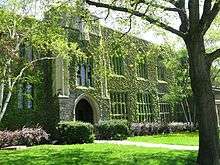 | |
| University of Toronto Faculty of Law | Queens Park Cres | ||
| Museum subway station | Queens Park Cres | University-Spadina line |  |
| Annesley Hall | Bloor St | University of Toronto residence | |
| Gardiner Museum | Bloor St |  | |
| McLaughlin Planetarium | Bloor St | Closed, and to be demolished | 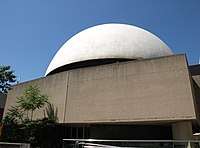 |
| Royal Ontario Museum | Bloor St | .jpg) | |
| Park Hyatt Toronto | Bloor St | ||
| Church of the Redeemer | Bloor St | ||
| Renaissance Plaza | Bloor St | 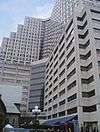 | |
| Four Seasons Hotel Toronto | Bloor St | ||
| Yorkville | Bloor St | Upscale shopping district | 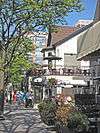 |
| Yorkville Village | Bloor St | ||
| Hare Krishna Temple | Dupont St | Formerly Avenue Road Church | |
| Church of the Messiah | Dupont St | ||
| De La Salle College | St Clair | 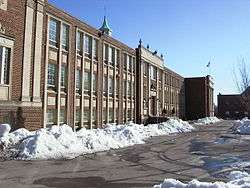 | |
| Deer Park United Church | St Clair | Closed since 2010 | 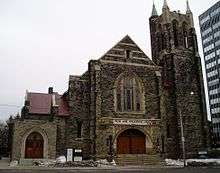 |
| Upper Canada College | Lonsdale Road | Avenue Road is interrupted by UCC | |
| Marshall McLuhan Catholic Secondary School | Eglinton Ave | ||
| Havergal College | Lawrence Ave | ||
| Armour Heights Public Library | Wilson Ave |
References
- "Google Maps showing Avenue Road's entire length". Retrieved 2010-11-25.
- Toronto Pocket Street Atlas, MapArt Publishing, 2000
- Robert Fulford. Accidental City: The Transformation of Toronto.
- Collins Street Atlas: M25 London Master, Collins, 2001
External links
| Wikimedia Commons has media related to Avenue Road, Toronto. |